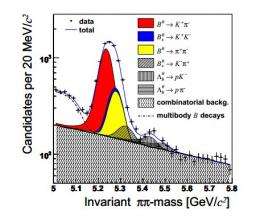March 1, 2012 report
Fermilab results add to confidence in explaining less antimatter amounts

(PhysOrg.com) -- The Standard Model of Physics suggests that shortly after the Big Bang there should have been the same amount of antimatter in existence as there was matter. As time passed, both should have decayed roughly equally, leaving roughly the same amounts of each today. But that is not the case of course as most everything today is matter and there is hardly any antimatter to be found.
To explain this, researchers theorize that antimatter must decay down to other particles at a different rate than does matter, but it can’t yet be proven positively. Researchers have come close though. Last November scientists working at the Large Hadron Collider found a difference of 0.8% in the decay rates of the subatomic particles known as D-mesons as they occur with matter and their associated antimatter particles.
Now, researchers working at the Collider Detector at Fermilab (CDF) have found a difference of 0.6% in the decay rates of the same particles adding considerable confidence to the theory. They have posted a paper describing their results on the preprint server arXiv and have also given a recent presentation outlining their findings at a particle physics meeting in Italy.
At the heart of the research is the idea of charge particle (CP) parity between matter and antimatter, or more specifically, CP violations, which occur when differences between the two are found. To find CP violations, researchers try to measure differences in decay rates between particles of each. If it can be proven that CP violations exist beyond statistical anomalies, then changes or addendums will have to be made to the standard model, which is of course a pretty big deal in physics.
To find CP violations in a real experiment, scientists turn to colliders which can produce among other things, D0 meson particles and their associated antimatter particles. In so doing they can then measure their decay rates. According to the standard model, the decay rates for one should not differ from the other by more than 0.1%. In the real world experiments, however, they did just that; first by 0.8% at the LHC, and then by 0.6% at the CDF.
This doesn’t prove anything conclusively though, because physicists have come up with a measurement system for providing a level of confidence in findings or discoveries. To be declared a discovery, an experiment would have to produce a 5 sigma. This latest experiment is only about 3.7 sigma, meaning the odds of the results being due to random chance are 1 in 10,000. To get to 5 sigma, those odds have to rise to one in a million.
More information: Measurements of Direct CP Violating Asymmetries in Charmless Decays of Strange Bottom Mesons and Bottom Baryons, arXiv:1103.5762v1 [hep-ex] xxx.lanl.gov/abs/1103.5762
Abstract
We report measurements of direct CP-violating asymmetries in charmless decays of neutral bottom hadrons to pairs of charged hadrons with the upgraded Collider Detector at the Fermilab Tevatron. Using a data sample corresponding to 1 fb-1 of integrated luminosity, we obtain the first measurements of direct CP violation in bottom strange mesons, A_CP(BsKpi) = +0.39 +- 0.15 stat +- 0.08 syst, and bottom baryons, A_CP(Lb->ppi) = +0.03 +- 0.17 stat +- 0.05 syst and A_CP(Lb->pK) = +0.37 +- 0.17 +- 0.03 syst. In addition, we measure CP violation in Bd-->Kpi decays with 3.5sigma significance, A_CP(B->Kpi) = -0.086 +- 0.023 stat +- 0.009 syst, in agreement with the current world average. Measurements of branching fractions of Bs-->K+K- and B0-->pi+pi- decays are also updated.
© 2011 PhysOrg.com

















